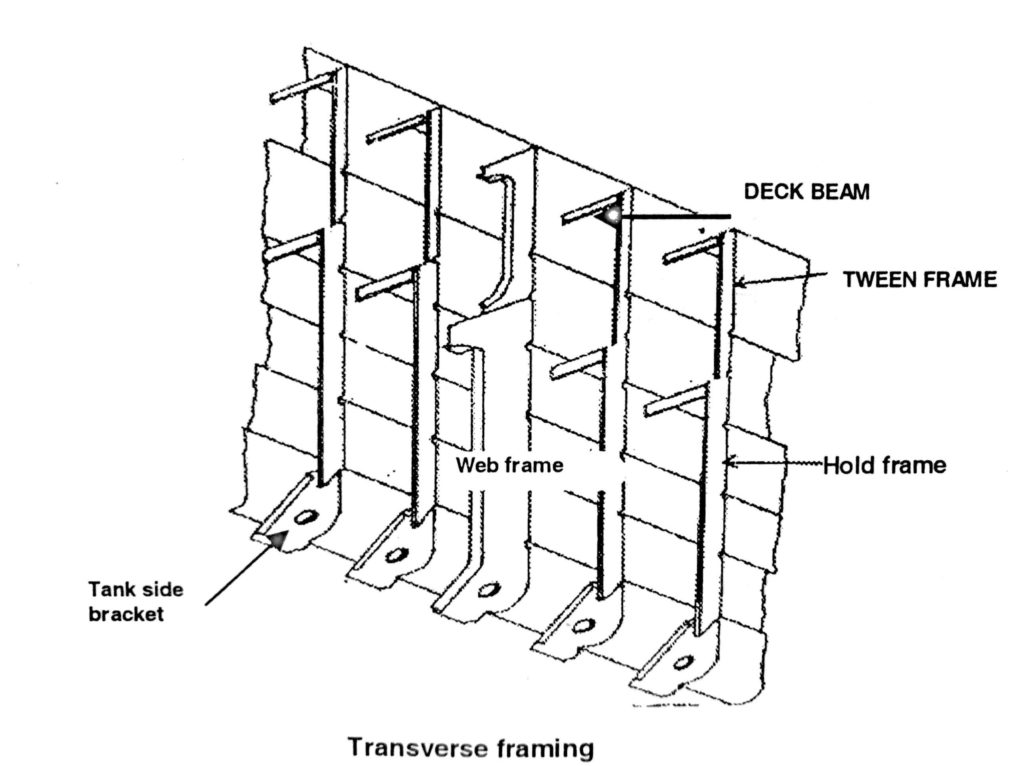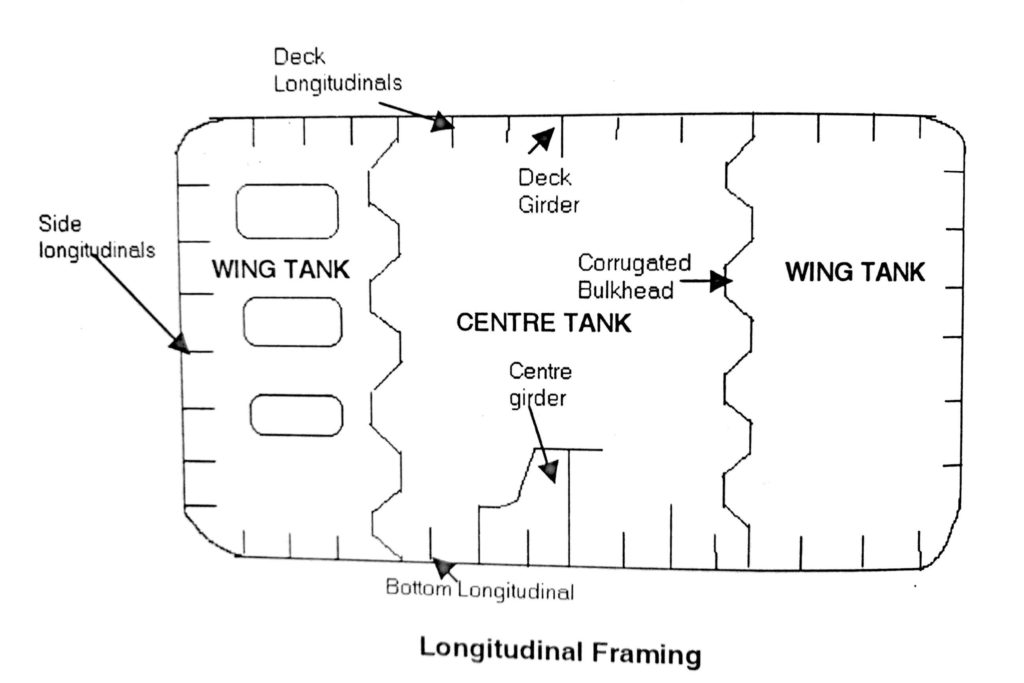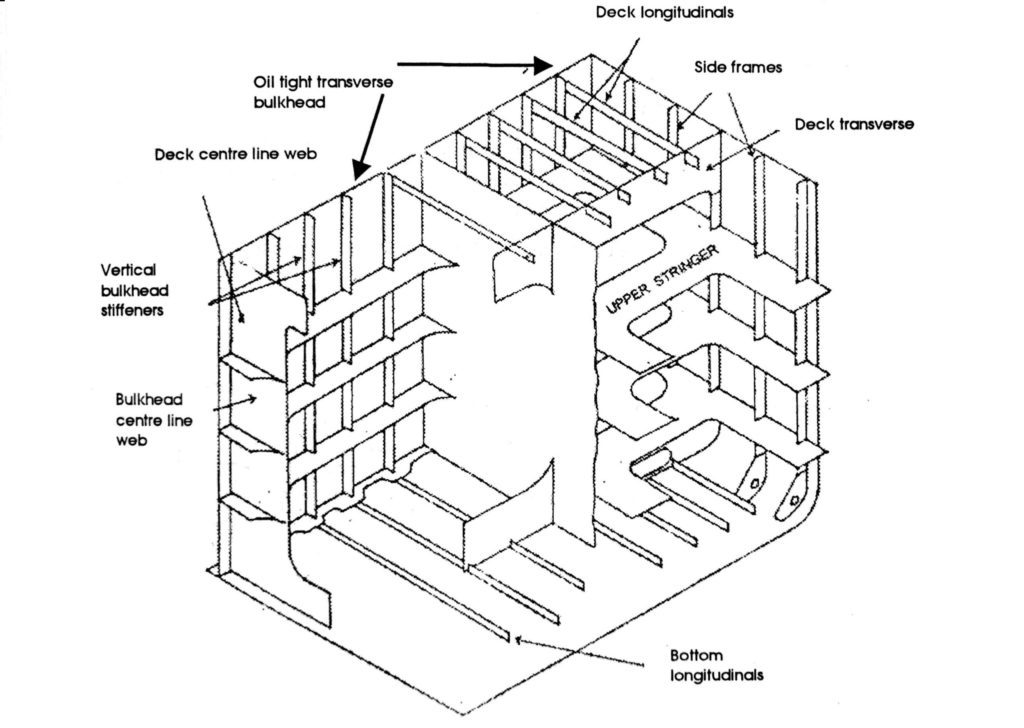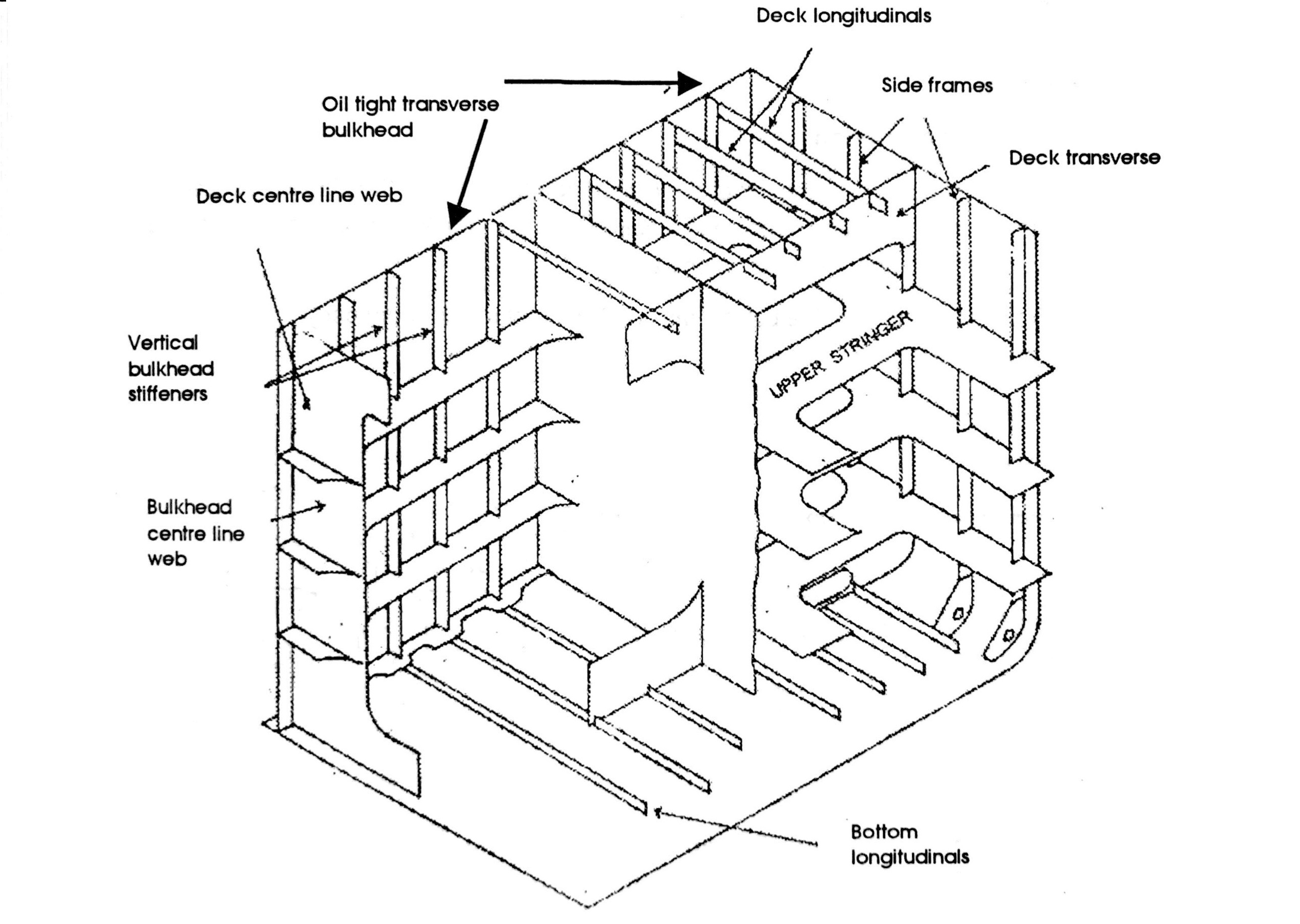Let us now look at the methods by which the designers ensure the strength in spite of these stresses.
Before we go further we would like you to see the following.
► A bulwark with its stay
► A booby hatch or a tank opening (hint: see from beneath the deck)
► A weathertight door on a mast locker. (Seen from inside the locker)
If you see these carefully, you shall notice that each has a strengthening feature. On the stay you will notice a bulb angle and an angle on the deck and the bulwark to connect it to the deck and provide a support.
Underneath the tank opening, you shall notice a supporting configuration of transverse beams and longitudinal webs each connected with a knee and a flat plate angle.
Inside the door, you shall observe stiffeners to compensate for the opening in the plate. All these features are seen throughout your ship to make it stronger.
What contributes to Strength?
The longitudinal strength members Consist Principally of keel, stem and stern posts, keelsons, bottom longitudinals, margin plates, and stringers. The transverse strength members consist of floors, frames and reversed frames, tank side brackets, beams, beam knees and pillars.
The shell, inner bottom and deck plating also add Considerably to the strength of the ship and form the most important part of the structure, not merely because they are vital to floatation but because the plating with frames and beams provide strength against the pressure of sea water and the load on decks. Such plating also constitutes the heaviest item of the steel that goes into building of a ship.
Transverse strength
Frames when connected to the transverse be make up the ribs of the ships. Transverse frames run from port to starboard. Where openings in decks are required, they are discontinued and strengthened at these openings to compensate for the loss of strength.
Wooden ships were always built on this system, because closely spaced transverse frames were needed to hold the planks together so that seams could be caulked. It was also necessary to use transverse framing because sailing ships needed considerable transverse strength to enable them to resist the stresses set up by the masts and rigging. The sailing ships with their masts and sails exerted a considerable stress on the hull. This stress tended to distort the transverse shape of the ship.
Longitudinal strength was less important in these ships because they were comparatively small and hogging and sagging stresses were not large.
This system is not the most efficient for steel steamships, but it has continued in general use until recently. This was partly because it was cheap to build and served its purpose and partly because a suitable alternative was not available for many years.

Longitudinal System
With the coming of steamships, racking stresses became less important, but hogging and sagging stresses became more serious as ships grew longer. It soon became obvious that more longitudinal strength could be achieved by running the frames longitudinally (fore and aft), provided that reasonable transverse strength was maintained.
Various attempts were made to do this during the 19th century, but all had serious disadvantages and none were generally adopted. Early in this century, a satisfactory system of longitudinal framing was invented which came to be called the ‘Isherwood System’, after its inventor.
This has longitudinal frames at the bottom, sides and decks, supported by widely spaced transverse web frames, called ‘transverses’. It gave great longitudinal strength and is much used for oil tankers and other types of bulk carrier.
A few dry cargo ships were built on this system, but now it is not used for cargo ships because the transverses interfere too much with the stowage of cargo. A large tanker as shown in the figure serves as a good illustration of the system.

Combination System
This was introduced to overcome the disadvantages of the longitudinal system for dry cargo ships. The longitudinal frames are retained in the bottom and under the decks where they give great longitudinal strength but transverse frames are fitted on the ship’s side. Where the longitudinal stresses are small, plate floors and heavy transverse beams are fitted at intervals to give transverse strength and to support the longitudinals.
This system was not widely used for riveted ships, although a number were built in this way, but it came more in to use with the coming of all-welded ships. This was partly because it was found that, if these ships were built on the transverse systems, their decks and bottom tended to corrugate under hogging and sagging stresses: whereas the longitudinal frames prevent this. Lloyds’ Rules now require longitudinals to be fitted, in general, in the bottoms and under strength decks of all ships of over 120 metres length.
It seems that this system will eventually replace the transverse framing on all larger dry cargo ships. The combination system is also often used for small to medium-sized oil tankers and for some other types of bulk carriers, for which it has certain advantages.

Cantilever Framing
To give longitudinal strength, the sheer strake and deck stringer plate are much heavier than normal, whilst the hatch side coamings are extra deep and are often made continuous throughout the ship. Sometimes, the hull is also extended upwards at the sheer strake, to form a strong box girder in place of the ordinary bulwark or rails. If the ships are of the ‘twin hatch type’ (with two hatches abreast), a deck girder or longitudinal bulkhead is also fitted at the centre line.
Double bottom


Running parallel to the centre girder are one or more side girders (depending on the breadth and the location on the ship. They provide additional strengthening at the base in ore carriers).
Solid Plate Floor(s): These are continuous floors extending from shipside/ Margin plate to the centre girder.
The inner & outer bottoms are framed either transversely (usually for V/L less than 120M) or longitudinally (for V/L 120 M or more in length, or if V/L is designed to carry ore or other heavy cargoes).
Transversely framed Double Bottoms
► Under the engines
► Under the Deep Tank bulkheads
► Under transverse bulkhead
►Under toes of brackets of deep tank bulkhead
►In the boundary region elsewhere at distances not exceeding 3.05 Metres.
►Bracket floors are placed at every frame space between the plate floors.
Longitudinally framed Double Bottoms
► In the region where the vessel tends to pound, that is slamming on the water due to heaving action, particularly in the fore part and
► Transverse bulkheads and the toes of stiffener brackets on deep tank.
They are fitted at alternate frames elsewhere.
One intercostals side girder is fitted on the port and & starboard side, if the ships breadth exceeds 14m, and where it exceeds 21 m, two are fitted on theport & stbd side. Additional side girders are provided as in the case of transversely framed double bottoms. As the unsupported span of the bottom longitudinals should not exceed 2.5m, vertical angle or channel bar struts may be provided to support the longitudinals between widely spaced solid floors.


Deep Tanks
Deep tanks as the name indicates, are tanks, which may extend from one deck to another. Fore peak and the afterpeak tank are the typical examples. They are used to take water ballast, dry cargo or liquid cargo. The tanks are located in the most suitable position for the trade or user requirements.
When they are needed as the ballast tanks they are located near to amidships. If they are used to trim the vessel then the deep tanks will be placed nearer to the ends of the vessel. Deep fore peak and after peak tanks for water ballast serve as trimming tanks in addition to increasing the displacement of the ship when filled.

Watertight Flats
It is necessary to ensure watertightness when the frame passes through a side stringer plate of a watertight deck. The most common method is to cut the frame at the under side of the watertight flat so that the stringer plate resting on the beams may be fitted close against the shell plating and be connected thereto by means of a continuous fore-and-aft angle bar or weld.
Frames
Flat bars, bulb bars, or inverted angles may be used for these. They may be attached to the hull by intermittent welds, or by continuous fillet welds. They are sometimes scalloped, but this is going out of favour because although it has some advantages, it adds considerably to the difficulties and cost of workmanship if it is to be properly done.
Web Frames: –
A modification of the web frame, called a ‘cantilever frame’, is used in some types of bulk carrier and is described in the chapter on ‘systems of construction’.
Numbering: – Frames are usually numbered from aft to forward, frame No.1 being the first one forward of the sternpost. The frames in cruiser sterns are usually lettered from the sternpost, (aft) forward.
Beams
►To tie the sides of the ship together and
Transverse Beams
Longitudinal Beams
At bulkheads, the longitudinals may be cut and bracketed to the bulkhead, as for bottom longitudinals, unless the ship is more than 215 metres long, when the longitudinals must be continuous.
At hatchways, the longitudinals are cut and attached to the hatch end beams by brackets.
Strong Beams
Half-Beams
Cargo Suspended from Beams
Beams may be attached to decks by intermittent or continuous fillet welds, or they may be scalloped, the same way as frames.
Beam Knees are used to connect beams to frames. There are various types, but for connecting frames to ordinary transverse beams the ‘plate bracket knee’ is used almost exclusively.
Welded plate bracket knees are not as efficient as they might be, because they have fairly large stress concentrations at their corners; but they are cheap and easy to fit and are strong enough for purposes where additional strength is not a requirement.
Large knees must have a flange at least 50 millimetres wide on their free edge. Frames and beams do not, in general, overlap, as the knee is considered to be a sufficient connection between them. When longitudinal beams are fitted, the knees at those frames where there is no transverse beam, must extend to the first longitudinal.



